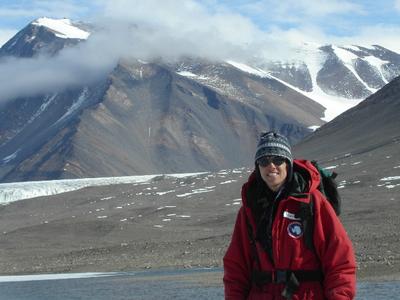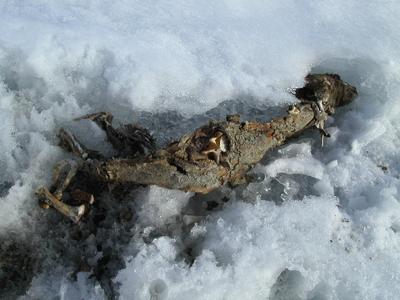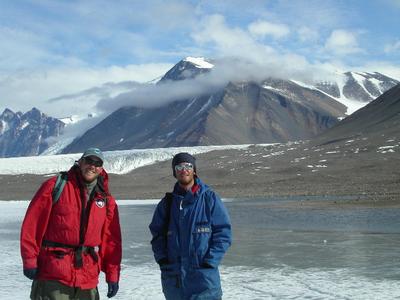
|
|
11 January, 2003
Good-Bye to Lake Fryxell
Yesterday Amber and Sarah spent the afternoon at the camp preparing us for
the move to our next camp by sorting through the food and repacking the cook
tent. This morning we were all up early to break down camp. After
breakfast, we started packing up our gear bags, sleeping bags, fleece
liners, foam pads and thermarest pads. ( A thermarest is an inflatable
sleeping pad. I'm quite grateful for the thermarest because we are sleeping
on the ground and the terrain is very rocky, but these pads provide a nice
cushion. ) After the inside of the tent is packed up and everything is
removed, we have to break down the tent. Fortunately, the wind was not bad
and so it came down easily.
All the rocks that had been gathered to secure our tents, and there were
many, had to be returned to their locations with an effort to place them in
the same spot we took them from, right side up, and facing the same
direction. This may seem a bit silly, but we try to minimize our impact on
the terrain. If you move a rock from one location to the next and leave it
there, a researcher such as a geologist may find it and make incorrect
observations about the area. The scientists rely on rocks, minerals,
sediments, moraines, wind directions, etc. to help determine the history of
the area. For example, the rock kenyte that I posted in my Jan 6th entry is
only found as far into the Taylor Valley as the Lake Fryxell Region. If I
collected rock samples at Lake Fryxell, and then when I arrived at Lake
Bonney I decided I didn't want them and left them at Bonney, that could
result in misinformation about the region. Kenyte deposits are evidence of
how far the Ross Ice Shelf once extended into the valley and are not found
beyond the Fryxell Region. So replacing rocks and keeping them in their
region is really quite important. Trying to orient them in the sand is also
important because they are shaped by the winds, so they form certain
patterns, which again give clues to the history of the region.
Once we had broken down the Scott tents, we began to prepare our sling loads
for the helo to pick up. We needed a total of four. We then waited in the
cook tent for the 12:30 arrival of the helo that would shuttle us from Lake
Fryxell to Lake Bonney. The wind had picked up and it had become quite cold
later in the morning. We left the mess tent up in case the weather turned
really bad and the helicopters could not fly, we would still have a shelter.
The cook tent is big enough for all nine of us to fit, so in an emergency,
we could all stay in there, protected from the wind, snow, and cold.
The helo arrived on time and Chris, Brenda, Sarah, and Sean were the first
four to be shuttled, along with two sling loads. The rest of us stayed
behind waiting for the helo to arrive to pick us up. While they were gone,
we then broke down the mess tent and prepared another sling load. I rode on
the next shuttle along with Amber and Tom. I shot more video from the air,
focusing on cinder cones and glaciers.
Happily, as we approached the camp, I could see that we would be setting up
near the established Lake Bonney camp. There is a jamesway (an arched
building approximately 40 x 15 feet in size) here with a kitchen, Internet
access, long table to work and eat at, and HEAT! We were all pleased
because we would be sharing the camp with our friends from the F6 camp who
would arrive on Monday.
After we landed at Lake Bonney, our work for the day was really just getting
started. The Bonney Camp is located on the slopes along the sides of the
valley. We had to establish a tent site and we found a suitable site about
200 yards up the hill. Hauling our gear and Scott tents up the mountainside
was not fun. A Scott tent ways over 90 pounds and our gear bags average
40-50 pounds each. Rock boxes, food boxes, two kitchen boxes, sleeping
gear, etc. all needed to be hauled up to the site. Up and down, up and
down, up and down for four hours, all
with a 20-25 knot head wind every time we set off up the hill. (Thanks Mike
for all those sessions on the stairmaster!) Large boulders had to be
gathered to secure our tent and because it was so windy we needed many rocks
and had to walk several yards to obtain some of them. We all worked hard and
put in a very long, exhausting day.
When we finished dinner, we all crawled into our tents and collapsed into
our sleeping bags.

On the far side of Lake Fryxell, we needed boats to get across the moat to the shore. Chris waded through the moat to bring the boat to the group on the ice. Jake jumped into the small boat and Chris pulled us ashore one at a time.

Two photos above.... that's Aaron and Jake on Lake Fryxell. Above, one last photo of me on Lake Fryxell.

Enjoying a last meal at Lake Fryxell. That's Sean, Sarah, Tom, Jake, and Chris... sitting on our ultra comfortable wooden rock boxes!

Seal remains found on the surface of Lake Fryxell. It is amazing how many miles (well over 10 miles) that seals will travel inland, apparently disoriented. Without a food source, they perish.

Jake and Brenda share a laugh at the coring site.

Jake at Fryxell
Contact the TEA in the field at
.
If you cannot connect through your browser, copy the
TEA's e-mail address in the "To:" line of
your favorite e-mail package.
|
